Questionnaire Development: Assessing Airline Service Preferences
VerifiedAdded on 2020/06/06
|7
|1375
|123
Report
AI Summary
This report focuses on the development of a questionnaire designed to assess customer satisfaction and buying intentions related to airline services, specifically comparing Low-Cost Carriers (LCCs) and Full-Service Carriers (FSCs). The report begins with an introduction outlining the research objectives, which include understanding the influence of brand image, customer satisfaction, and value on future buying intentions. Task 1 delves into the structure of the questionnaire, emphasizing the use of both open-ended and closed-ended questions to gather both statistical data and qualitative insights. It discusses the funnel technique and the use of 'ringer' or 'throw-away' questions to engage respondents. The report then outlines the key steps in questionnaire design, including defining objectives, identifying attributes, selecting the target audience, choosing a method of reaching the audience, defining question content, framing questions effectively, sequencing questions logically, selecting appropriate measurement scales, checking questionnaire length, and ensuring reliability. An example questionnaire is provided, illustrating question content and structure, and the report concludes by summarizing the significant role of questionnaire structure and design in attracting respondents and obtaining accurate responses. The report references relevant books and journals to support its findings.
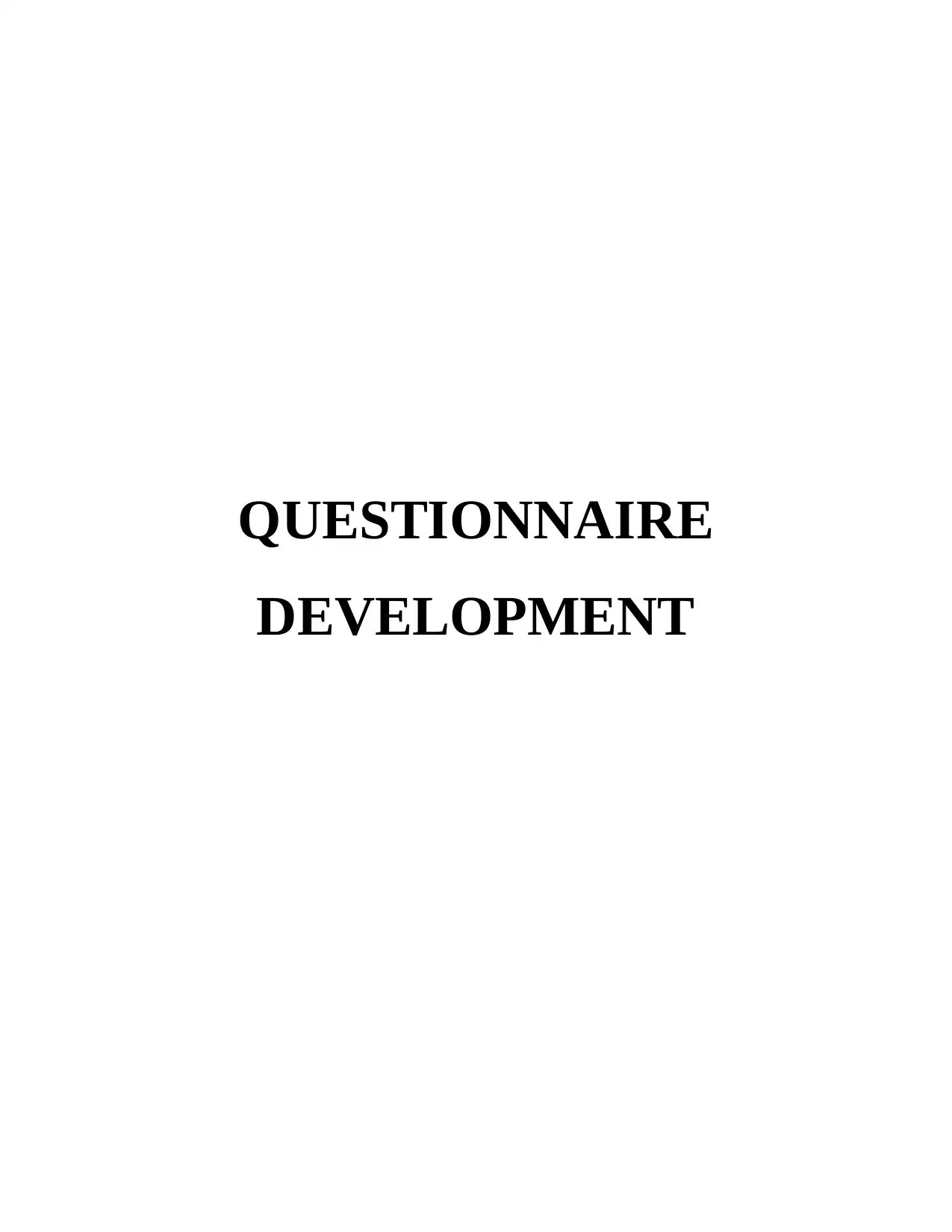
QUESTIONNAIRE
DEVELOPMENT
DEVELOPMENT
Paraphrase This Document
Need a fresh take? Get an instant paraphrase of this document with our AI Paraphraser
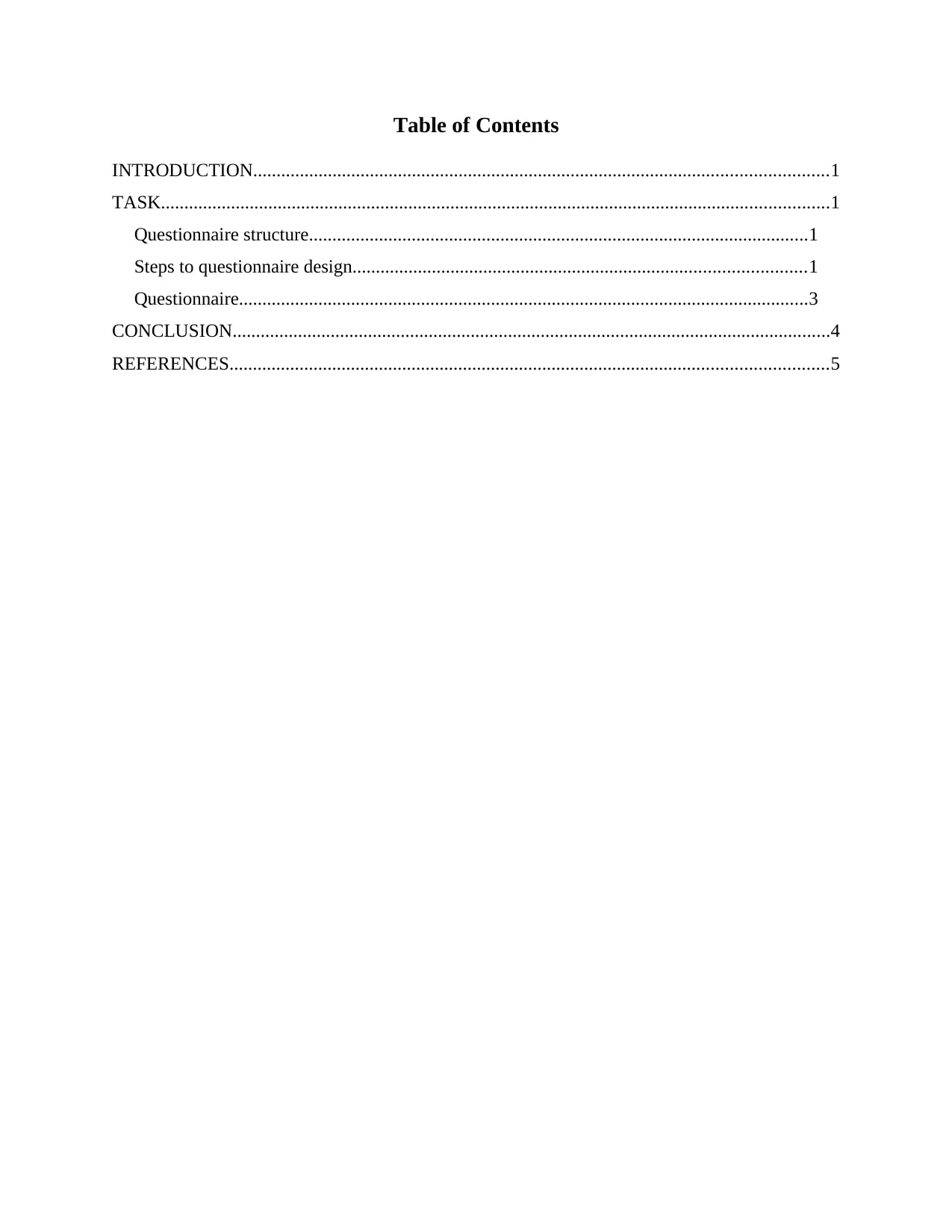
Table of Contents
INTRODUCTION...........................................................................................................................1
TASK...............................................................................................................................................1
Questionnaire structure...........................................................................................................1
Steps to questionnaire design.................................................................................................1
Questionnaire..........................................................................................................................3
CONCLUSION................................................................................................................................4
REFERENCES................................................................................................................................5
INTRODUCTION...........................................................................................................................1
TASK...............................................................................................................................................1
Questionnaire structure...........................................................................................................1
Steps to questionnaire design.................................................................................................1
Questionnaire..........................................................................................................................3
CONCLUSION................................................................................................................................4
REFERENCES................................................................................................................................5
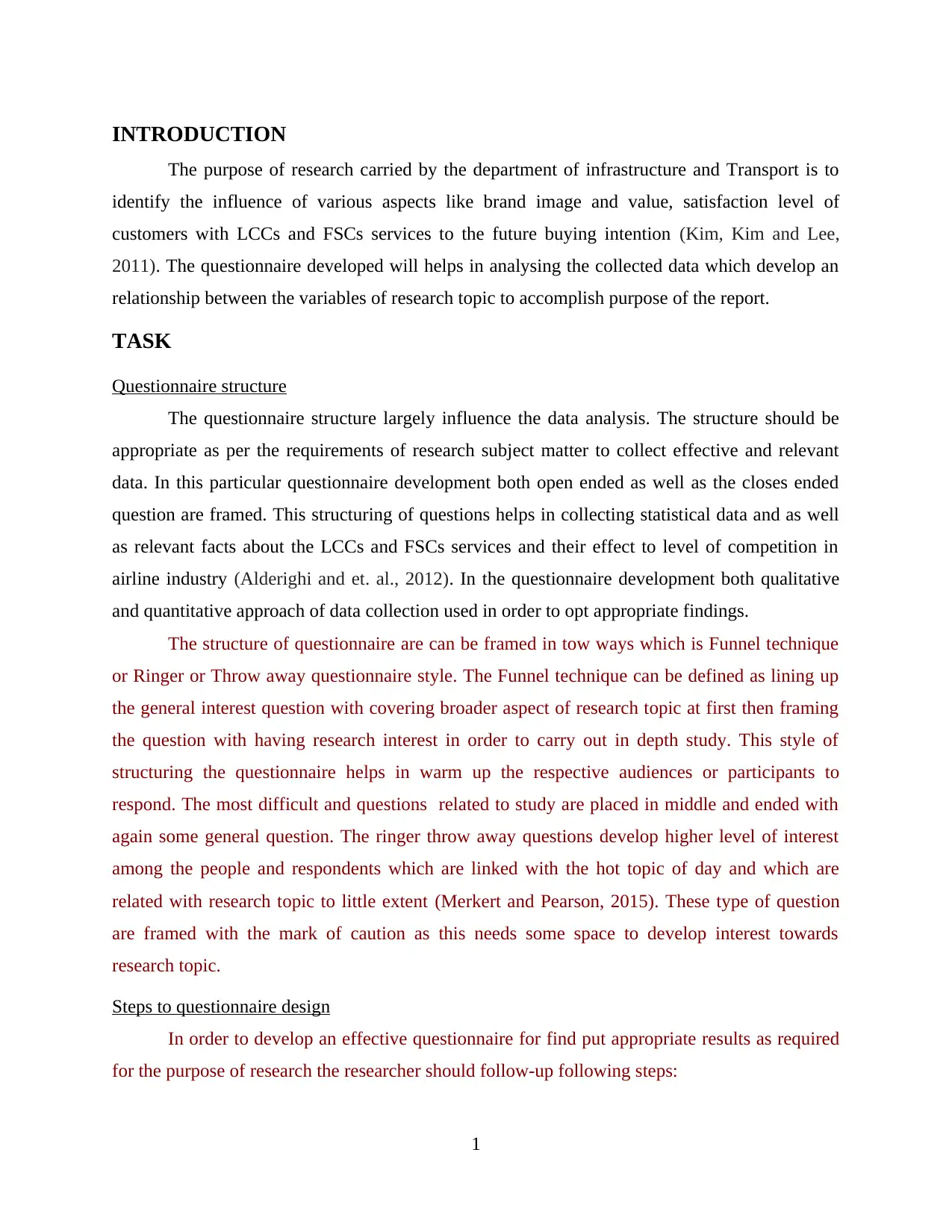
INTRODUCTION
The purpose of research carried by the department of infrastructure and Transport is to
identify the influence of various aspects like brand image and value, satisfaction level of
customers with LCCs and FSCs services to the future buying intention (Kim, Kim and Lee,
2011). The questionnaire developed will helps in analysing the collected data which develop an
relationship between the variables of research topic to accomplish purpose of the report.
TASK
Questionnaire structure
The questionnaire structure largely influence the data analysis. The structure should be
appropriate as per the requirements of research subject matter to collect effective and relevant
data. In this particular questionnaire development both open ended as well as the closes ended
question are framed. This structuring of questions helps in collecting statistical data and as well
as relevant facts about the LCCs and FSCs services and their effect to level of competition in
airline industry (Alderighi and et. al., 2012). In the questionnaire development both qualitative
and quantitative approach of data collection used in order to opt appropriate findings.
The structure of questionnaire are can be framed in tow ways which is Funnel technique
or Ringer or Throw away questionnaire style. The Funnel technique can be defined as lining up
the general interest question with covering broader aspect of research topic at first then framing
the question with having research interest in order to carry out in depth study. This style of
structuring the questionnaire helps in warm up the respective audiences or participants to
respond. The most difficult and questions related to study are placed in middle and ended with
again some general question. The ringer throw away questions develop higher level of interest
among the people and respondents which are linked with the hot topic of day and which are
related with research topic to little extent (Merkert and Pearson, 2015). These type of question
are framed with the mark of caution as this needs some space to develop interest towards
research topic.
Steps to questionnaire design
In order to develop an effective questionnaire for find put appropriate results as required
for the purpose of research the researcher should follow-up following steps:
1
The purpose of research carried by the department of infrastructure and Transport is to
identify the influence of various aspects like brand image and value, satisfaction level of
customers with LCCs and FSCs services to the future buying intention (Kim, Kim and Lee,
2011). The questionnaire developed will helps in analysing the collected data which develop an
relationship between the variables of research topic to accomplish purpose of the report.
TASK
Questionnaire structure
The questionnaire structure largely influence the data analysis. The structure should be
appropriate as per the requirements of research subject matter to collect effective and relevant
data. In this particular questionnaire development both open ended as well as the closes ended
question are framed. This structuring of questions helps in collecting statistical data and as well
as relevant facts about the LCCs and FSCs services and their effect to level of competition in
airline industry (Alderighi and et. al., 2012). In the questionnaire development both qualitative
and quantitative approach of data collection used in order to opt appropriate findings.
The structure of questionnaire are can be framed in tow ways which is Funnel technique
or Ringer or Throw away questionnaire style. The Funnel technique can be defined as lining up
the general interest question with covering broader aspect of research topic at first then framing
the question with having research interest in order to carry out in depth study. This style of
structuring the questionnaire helps in warm up the respective audiences or participants to
respond. The most difficult and questions related to study are placed in middle and ended with
again some general question. The ringer throw away questions develop higher level of interest
among the people and respondents which are linked with the hot topic of day and which are
related with research topic to little extent (Merkert and Pearson, 2015). These type of question
are framed with the mark of caution as this needs some space to develop interest towards
research topic.
Steps to questionnaire design
In order to develop an effective questionnaire for find put appropriate results as required
for the purpose of research the researcher should follow-up following steps:
1
⊘ This is a preview!⊘
Do you want full access?
Subscribe today to unlock all pages.

Trusted by 1+ million students worldwide
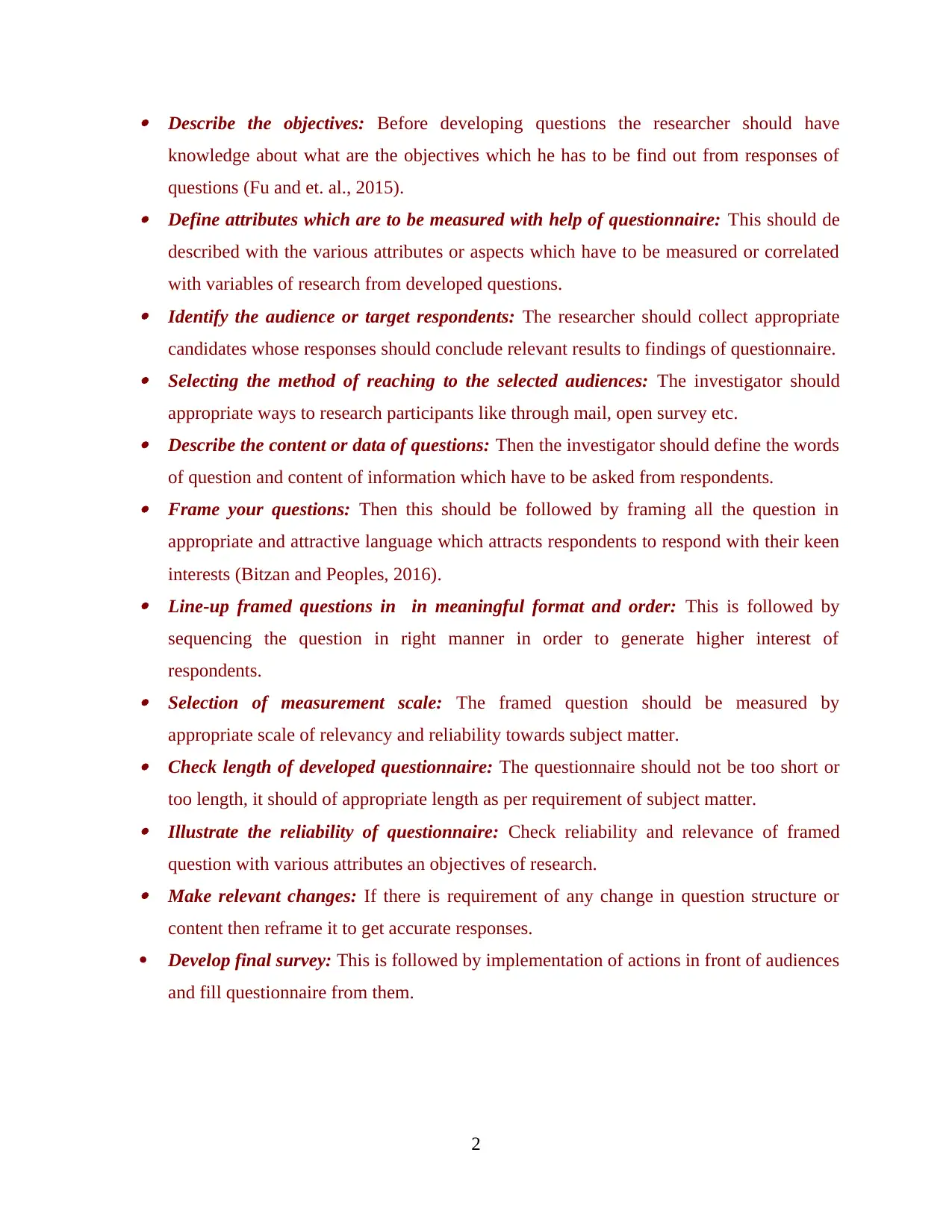
Describe the objectives: Before developing questions the researcher should have
knowledge about what are the objectives which he has to be find out from responses of
questions (Fu and et. al., 2015). Define attributes which are to be measured with help of questionnaire: This should de
described with the various attributes or aspects which have to be measured or correlated
with variables of research from developed questions. Identify the audience or target respondents: The researcher should collect appropriate
candidates whose responses should conclude relevant results to findings of questionnaire. Selecting the method of reaching to the selected audiences: The investigator should
appropriate ways to research participants like through mail, open survey etc. Describe the content or data of questions: Then the investigator should define the words
of question and content of information which have to be asked from respondents. Frame your questions: Then this should be followed by framing all the question in
appropriate and attractive language which attracts respondents to respond with their keen
interests (Bitzan and Peoples, 2016). Line-up framed questions in in meaningful format and order: This is followed by
sequencing the question in right manner in order to generate higher interest of
respondents. Selection of measurement scale: The framed question should be measured by
appropriate scale of relevancy and reliability towards subject matter. Check length of developed questionnaire: The questionnaire should not be too short or
too length, it should of appropriate length as per requirement of subject matter. Illustrate the reliability of questionnaire: Check reliability and relevance of framed
question with various attributes an objectives of research. Make relevant changes: If there is requirement of any change in question structure or
content then reframe it to get accurate responses.
Develop final survey: This is followed by implementation of actions in front of audiences
and fill questionnaire from them.
2
knowledge about what are the objectives which he has to be find out from responses of
questions (Fu and et. al., 2015). Define attributes which are to be measured with help of questionnaire: This should de
described with the various attributes or aspects which have to be measured or correlated
with variables of research from developed questions. Identify the audience or target respondents: The researcher should collect appropriate
candidates whose responses should conclude relevant results to findings of questionnaire. Selecting the method of reaching to the selected audiences: The investigator should
appropriate ways to research participants like through mail, open survey etc. Describe the content or data of questions: Then the investigator should define the words
of question and content of information which have to be asked from respondents. Frame your questions: Then this should be followed by framing all the question in
appropriate and attractive language which attracts respondents to respond with their keen
interests (Bitzan and Peoples, 2016). Line-up framed questions in in meaningful format and order: This is followed by
sequencing the question in right manner in order to generate higher interest of
respondents. Selection of measurement scale: The framed question should be measured by
appropriate scale of relevancy and reliability towards subject matter. Check length of developed questionnaire: The questionnaire should not be too short or
too length, it should of appropriate length as per requirement of subject matter. Illustrate the reliability of questionnaire: Check reliability and relevance of framed
question with various attributes an objectives of research. Make relevant changes: If there is requirement of any change in question structure or
content then reframe it to get accurate responses.
Develop final survey: This is followed by implementation of actions in front of audiences
and fill questionnaire from them.
2
Paraphrase This Document
Need a fresh take? Get an instant paraphrase of this document with our AI Paraphraser
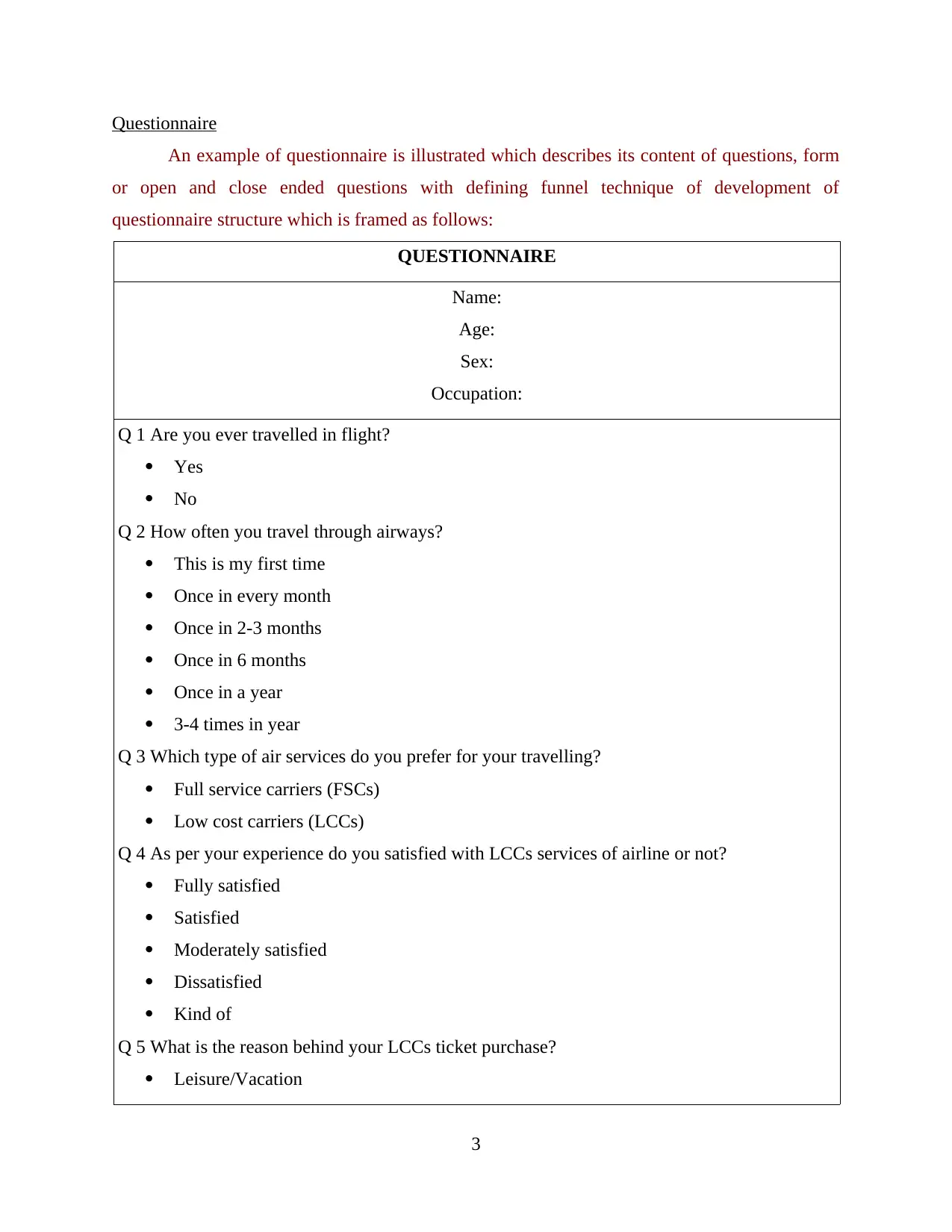
Questionnaire
An example of questionnaire is illustrated which describes its content of questions, form
or open and close ended questions with defining funnel technique of development of
questionnaire structure which is framed as follows:
QUESTIONNAIRE
Name:
Age:
Sex:
Occupation:
Q 1 Are you ever travelled in flight?
Yes
No
Q 2 How often you travel through airways?
This is my first time
Once in every month
Once in 2-3 months
Once in 6 months
Once in a year
3-4 times in year
Q 3 Which type of air services do you prefer for your travelling?
Full service carriers (FSCs)
Low cost carriers (LCCs)
Q 4 As per your experience do you satisfied with LCCs services of airline or not?
Fully satisfied
Satisfied
Moderately satisfied
Dissatisfied
Kind of
Q 5 What is the reason behind your LCCs ticket purchase?
Leisure/Vacation
3
An example of questionnaire is illustrated which describes its content of questions, form
or open and close ended questions with defining funnel technique of development of
questionnaire structure which is framed as follows:
QUESTIONNAIRE
Name:
Age:
Sex:
Occupation:
Q 1 Are you ever travelled in flight?
Yes
No
Q 2 How often you travel through airways?
This is my first time
Once in every month
Once in 2-3 months
Once in 6 months
Once in a year
3-4 times in year
Q 3 Which type of air services do you prefer for your travelling?
Full service carriers (FSCs)
Low cost carriers (LCCs)
Q 4 As per your experience do you satisfied with LCCs services of airline or not?
Fully satisfied
Satisfied
Moderately satisfied
Dissatisfied
Kind of
Q 5 What is the reason behind your LCCs ticket purchase?
Leisure/Vacation
3
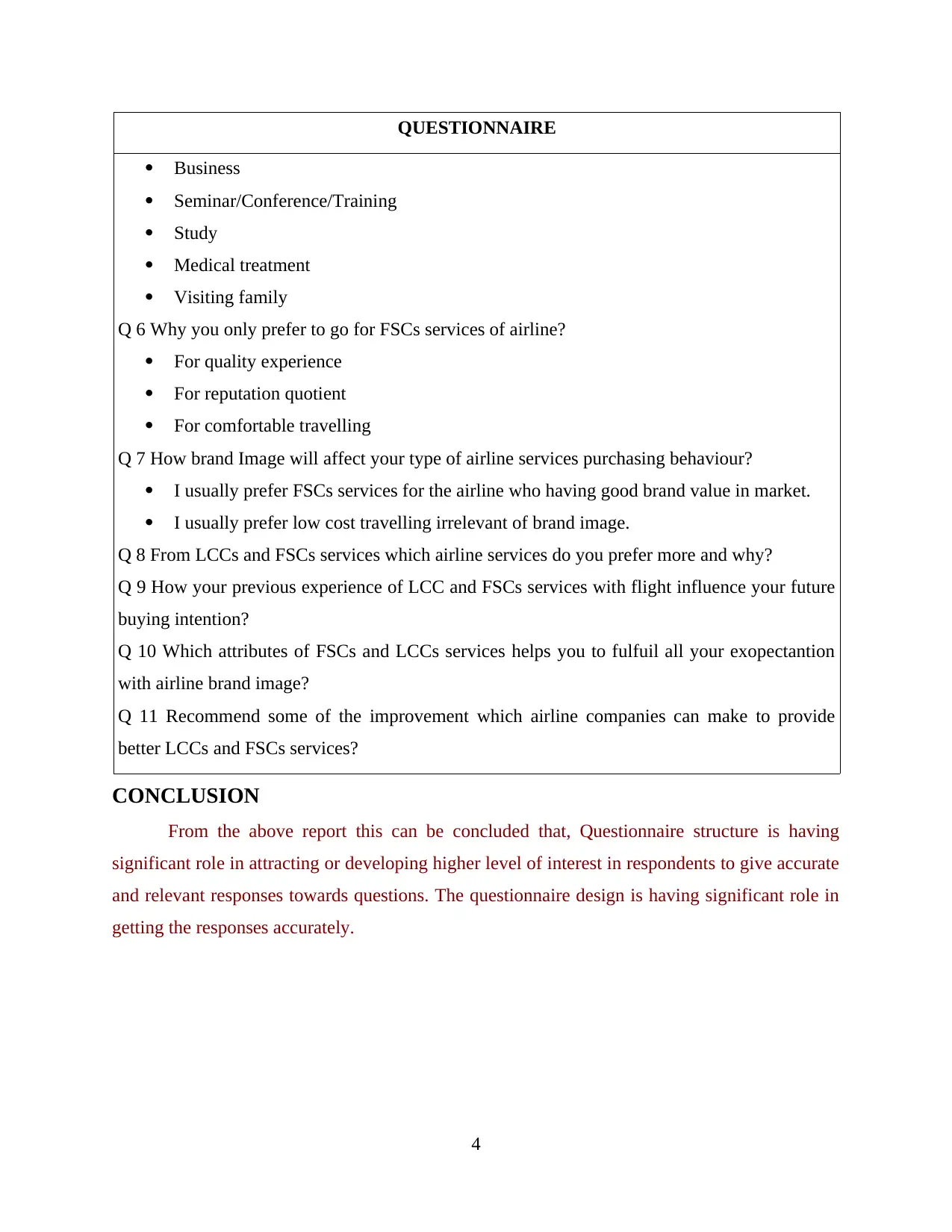
QUESTIONNAIRE
Business
Seminar/Conference/Training
Study
Medical treatment
Visiting family
Q 6 Why you only prefer to go for FSCs services of airline?
For quality experience
For reputation quotient
For comfortable travelling
Q 7 How brand Image will affect your type of airline services purchasing behaviour?
I usually prefer FSCs services for the airline who having good brand value in market.
I usually prefer low cost travelling irrelevant of brand image.
Q 8 From LCCs and FSCs services which airline services do you prefer more and why?
Q 9 How your previous experience of LCC and FSCs services with flight influence your future
buying intention?
Q 10 Which attributes of FSCs and LCCs services helps you to fulfuil all your exopectantion
with airline brand image?
Q 11 Recommend some of the improvement which airline companies can make to provide
better LCCs and FSCs services?
CONCLUSION
From the above report this can be concluded that, Questionnaire structure is having
significant role in attracting or developing higher level of interest in respondents to give accurate
and relevant responses towards questions. The questionnaire design is having significant role in
getting the responses accurately.
4
Business
Seminar/Conference/Training
Study
Medical treatment
Visiting family
Q 6 Why you only prefer to go for FSCs services of airline?
For quality experience
For reputation quotient
For comfortable travelling
Q 7 How brand Image will affect your type of airline services purchasing behaviour?
I usually prefer FSCs services for the airline who having good brand value in market.
I usually prefer low cost travelling irrelevant of brand image.
Q 8 From LCCs and FSCs services which airline services do you prefer more and why?
Q 9 How your previous experience of LCC and FSCs services with flight influence your future
buying intention?
Q 10 Which attributes of FSCs and LCCs services helps you to fulfuil all your exopectantion
with airline brand image?
Q 11 Recommend some of the improvement which airline companies can make to provide
better LCCs and FSCs services?
CONCLUSION
From the above report this can be concluded that, Questionnaire structure is having
significant role in attracting or developing higher level of interest in respondents to give accurate
and relevant responses towards questions. The questionnaire design is having significant role in
getting the responses accurately.
4
⊘ This is a preview!⊘
Do you want full access?
Subscribe today to unlock all pages.

Trusted by 1+ million students worldwide
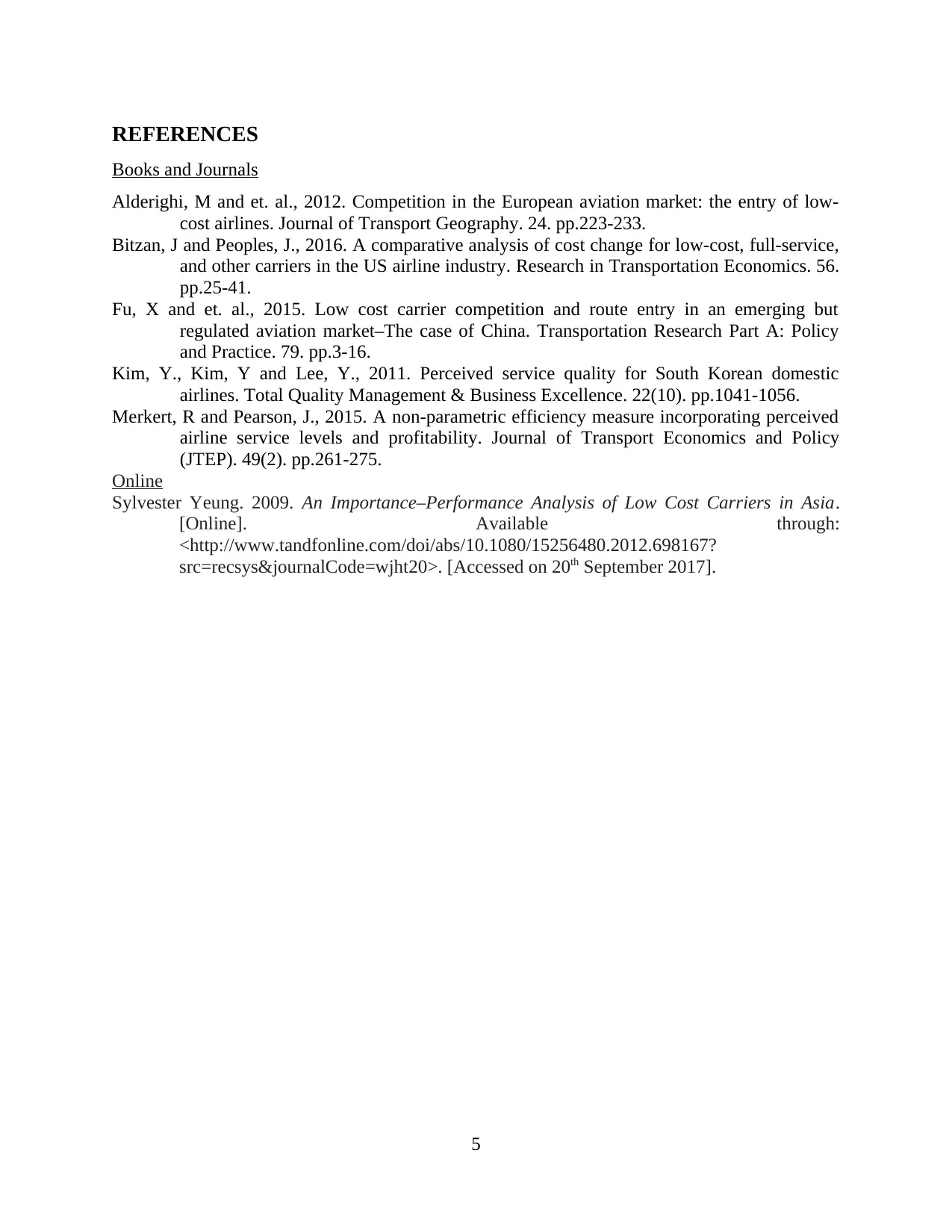
REFERENCES
Books and Journals
Alderighi, M and et. al., 2012. Competition in the European aviation market: the entry of low-
cost airlines. Journal of Transport Geography. 24. pp.223-233.
Bitzan, J and Peoples, J., 2016. A comparative analysis of cost change for low-cost, full-service,
and other carriers in the US airline industry. Research in Transportation Economics. 56.
pp.25-41.
Fu, X and et. al., 2015. Low cost carrier competition and route entry in an emerging but
regulated aviation market–The case of China. Transportation Research Part A: Policy
and Practice. 79. pp.3-16.
Kim, Y., Kim, Y and Lee, Y., 2011. Perceived service quality for South Korean domestic
airlines. Total Quality Management & Business Excellence. 22(10). pp.1041-1056.
Merkert, R and Pearson, J., 2015. A non-parametric efficiency measure incorporating perceived
airline service levels and profitability. Journal of Transport Economics and Policy
(JTEP). 49(2). pp.261-275.
Online
Sylvester Yeung. 2009. An Importance–Performance Analysis of Low Cost Carriers in Asia.
[Online]. Available through:
<http://www.tandfonline.com/doi/abs/10.1080/15256480.2012.698167?
src=recsys&journalCode=wjht20>. [Accessed on 20th September 2017].
5
Books and Journals
Alderighi, M and et. al., 2012. Competition in the European aviation market: the entry of low-
cost airlines. Journal of Transport Geography. 24. pp.223-233.
Bitzan, J and Peoples, J., 2016. A comparative analysis of cost change for low-cost, full-service,
and other carriers in the US airline industry. Research in Transportation Economics. 56.
pp.25-41.
Fu, X and et. al., 2015. Low cost carrier competition and route entry in an emerging but
regulated aviation market–The case of China. Transportation Research Part A: Policy
and Practice. 79. pp.3-16.
Kim, Y., Kim, Y and Lee, Y., 2011. Perceived service quality for South Korean domestic
airlines. Total Quality Management & Business Excellence. 22(10). pp.1041-1056.
Merkert, R and Pearson, J., 2015. A non-parametric efficiency measure incorporating perceived
airline service levels and profitability. Journal of Transport Economics and Policy
(JTEP). 49(2). pp.261-275.
Online
Sylvester Yeung. 2009. An Importance–Performance Analysis of Low Cost Carriers in Asia.
[Online]. Available through:
<http://www.tandfonline.com/doi/abs/10.1080/15256480.2012.698167?
src=recsys&journalCode=wjht20>. [Accessed on 20th September 2017].
5
1 out of 7
Related Documents
Your All-in-One AI-Powered Toolkit for Academic Success.
+13062052269
info@desklib.com
Available 24*7 on WhatsApp / Email
![[object Object]](/_next/static/media/star-bottom.7253800d.svg)
Unlock your academic potential
Copyright © 2020–2025 A2Z Services. All Rights Reserved. Developed and managed by ZUCOL.




